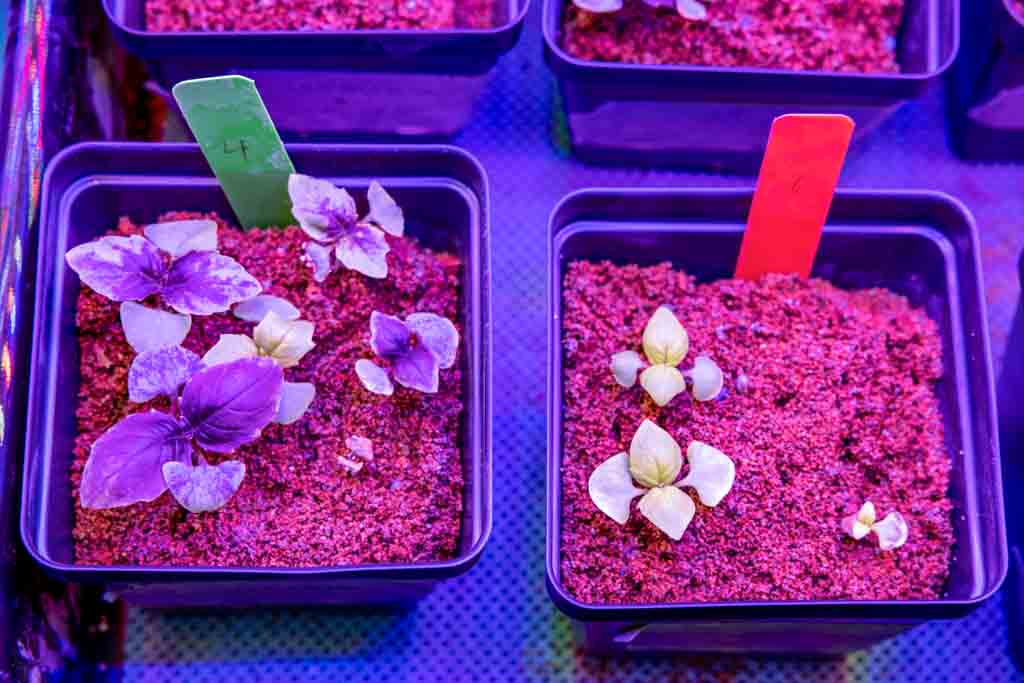For astronauts to walk on the moon, plenty of boots are needed on the ground—in this case, the classroom. Calgary Academy is proud to say that some of its students are applying classroom learning to the real world, helping further NASA research.
Walking the halls of Calgary Academy, you may notice a glowing, neon-pink light coming from the Senior School science lab. For the next few months, this lab is serving as a home base for a unique extracurricular project: Growing Beyond Earth.
What Is Growing Beyond Earth?
Growing Beyond Earth is a classroom-based science project that provides meaningful data for NASA. Students help test how plants grow in certain environmental conditions, helping NASA determine which plants are suitable for the International Space Station (ISS) and future space travel.
With hundreds of schools (including Calgary Academy) participating, NASA receives thousands of data points to help identify space-ready vegetables. Each classroom uses a plant habitat similar to the vegetable system used on the ISS, known as Veggie.
While working alongside NASA is an amazing opportunity, what’s interesting about this project is the real-world learning students experience—something project coordinator and CA physics teacher Rebecca Keeler agrees with.
Real-World Context Takes Learning to a Higher Level
Participating students in Growing Beyond Earth get hands-on learning outside of the classroom. Junior and senior high students have come together to learn more about science in an applied setting.
 Ms. Keeler believes that students see how different subjects, like biology and physics, come together during research.
Ms. Keeler believes that students see how different subjects, like biology and physics, come together during research.
Learning can happen in a vacuum during school, but answers aren’t always in the back of a textbook.
Ms. Keeler emphasizes that students must keep an open mind during this project—the results they get may not be the ones they expect.
“Nothing is ever quite as we expect when we do research. You can learn new things every time you do something.”
Students in this extracurricular project get to participate in NASA research, building and setting up the plant habitat, planting different test subjects and monitoring progress as time goes on.
Nineteen days into Growing Beyond Earth, students are almost halfway through their first research trial. Some basil plants have thrived, while others are yet to bloom. Participating students are seeing the tangible results of the scientific method. Ms. Keeler says this project is a lesson on how STEM (science, technology, engineering, and math)-related fields work outside the classroom.
“As much as you plan for things in the science world… In real life, it never turns out that way. I think this project teaches that as much as you understand a concept, research isn’t going to be exactly like what you were taught.” – Ms. Keeler
Besides teaching new lessons, Growing Beyond Earth shows students what a future career in STEM can be. Whether in botany or aeronautics, the future is bright for budding scientists at Calgary Academy.
“This project allows students to see what opportunities are out there for their future lives and careers… Seeing the application of what we do in the class can help students see a future path for themselves.” – Ms. Keeler
What’s Next for Growing Beyond Earth?
Growing Beyond Earth involves two trial periods, the first following NASA-regulated protocols—the second a student-driven trial. Ms. Keeler and her students will draft a research proposal for a 49-day trial period. After both trials are complete, there is a video chat with NASA researchers to present project results.
A research symposium is planned for April, held by NASA to show the results of the multi-school and nation project, and Ms. Keeler and her students plan to participate virtually. This symposium is a fitting end for the project, showcasing what different schools have learned over several months of research.
Growing Beyond Earth is teaching something to all involved—real-world learning for students, plant data for NASA, and a reminder of the love of teaching for Ms. Keeler.
“It keeps me personally engaged and excited to teach when I get to do things like Growing Beyond Earth. I was super excited that Calgary Academy supported this project.”
If you’re interested in seeing the progress Growing Beyond Earth has made, check back in April when Ms. Keeler and her students plan to meet with NASA and share their findings.
An Update on Growing Beyond Earth
After completing both project trials, the Growing Beyond Earth team met with NASA researchers at the end of April. During this video chat, students presented their findings on how their basil grew under different lighting and growing conditions. Participating with several other schools across North America, the team is happy to call this project a success!
